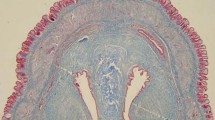Summary
The hemodynamic characteristics of 92 patients with idiopathic Peyronie's disease who underwent a dynamic-infusion pharmacocavernosometry and pharmacocavernosography (DICC) examination as part of their initial evaluation were reviewed. In all, 86% of patients demonstrated cavernosometric evidence of corporal veno-occlusive dysfunction. A 71% incidence of corporal veno-occlusive dysfunction was seen by cavernosometry in patients without vascular risk factors, suggesting that Peyronie's disease may be associated with intrinsic alterations in the penile fibroelastic frame compliance. In 62% of patients with abnormal cavernosography, a unique, heretofore undescribed cavernosographic “pitchfork” pattern was observed, derived from the abrupt filling of the dorsal vein and the corpus spongiosum just proximal to the Peyronie's plaque. Delamination, subsequent inflammation, and plaque formation at the junction of the dorsal and ventral circular fibers of the tunica with the fibers of the septum may account for this unique pattern of plaque-associated venous drainage. In all, 78% of patients demonstrated abnormal cavernosal artery systolic occlusion pressures as compared with simultaneous brachial artery systolic occlusion pressures. Hemodynamic abnormalities were observed in patients having regular intercourse and in those denying changes in the quality of their penile erections. To aid in the management of the disorder, it is suggested that prior to treatment, especially reconstructive surgery, a hemodynamic assessment of the erectile mechanism by DICC be performed.
Similar content being viewed by others
References
Bailey MJ, Yande S, Walmsley B, Pryor JP (1985) Surgery for Peyronie's disease: a review of 200 patients. Br J Urol 57:746–749
Bar-Moshe O, Vandendris M (1986) Peyronie's disease and venous leakage (letter). J Urol 136:689
Chilton CP, Castle WM, Westwood CA, Pryor JP (1982) Factors associated in the aetiology of Peyronie's disease. Br J Urol 54:748–750
Coughlin PWF, Carson CC III, Paulson DF (1984) Surgical correction of Peyronie's disease: the Nesbit procedure. J Urol 131:282–285
Devine CJ Jr (1989) What causes plaque formation? Current concepts. J Urol 141:57A (presented at the Endocrine Forum, 1989 AUA National Meeting)
Devine CJ Jr, Horton CE (1983) Surgical treatment of Peyronie's disease with a dermal graft. J Urol 111:44–49
Furlow WL, Swenson HE Jr, Lee RE (1975) Peyronie's disease: a study of its natural history and treatment with orthovoltage radiotherapy. J Urol 114:69–71
Gelbard MK, Lindner A, Kaufman JJ (1983) The use of collagenase in the treatment of Peyronie's disease. J Urol 134:280–283
Goldstein I, Krane RJ, Greenfield AJ, Padma-Nathan H (1990) Vascular diseases of the penis: impotence and priapism. In: Pollack HM (ed) Clinical urography. Saunders, Philadelphia, pp 2231–2252
Krane RJ, Goldstein I, Saenz de Tejada I (1989) Impotence. New Engl J Med 321:1648–1659
Metz P, Ebbehoj J, Uhrenholdt A, Wagner G (1983) Peyronie's disease and erectile failure. J Urol 130:1103–1104
Miller HC, Ardizzone J (1983) Peyronie's disease treated with ultrasound and hydrocortisone. Urology 21:584–585
Nyberg LM, Bias WB, Hochberg MC, Walsh PC (1982) Identification of an inherited form of Peyronie's disease with autosomal dominant inheritance and associated with Dupuytren's contracture and histocompatability B7 cross-reacting antigens. J Urol 128:48–51
Peyronie F de la (1743) Sur quelques obstacles qui s'opposent à l'éjaculation naturelle de la semence. Mem Acad Chir 425–434 (new edition) (1819) 316–323
Pryor JP (1988) Peyronie's disease and impotence. Acta Urol Belg 56:317–321
Roddy TM, Goldstein I (1990) Peyronie's disease. AUA Update (in press)
Smith BH (1969) Peyronie's disease. Am J Clin Pathol 45:670–678
Smith BH (1966) Subclinical Peyronie's disease. Am J Clin Pathol 52:385–390
Williams JL, Thomas GG (1970) The natural history of Peyronie's disease. J Urol 103:75–76
Ziegelbaum M, Thomas A Jr, Zachary AA (1987) The association of Peyronie's disease with HLA B7 cross-reactive antigens: a case report of identical twins. Cleve Clin J Med 54:427–430
Author information
Authors and Affiliations
Rights and permissions
About this article
Cite this article
Gasior, B.L., Levine, F.J., Howannesian, A. et al. Plaque-associated corporal veno-occlusive dysfunction in idiopathic Peyronie's disease: A pharmacocavernosometric and pharmacocavernosographic study. World J Urol 8, 90–96 (1990). https://doi.org/10.1007/BF01576355
Issue Date:
DOI: https://doi.org/10.1007/BF01576355




